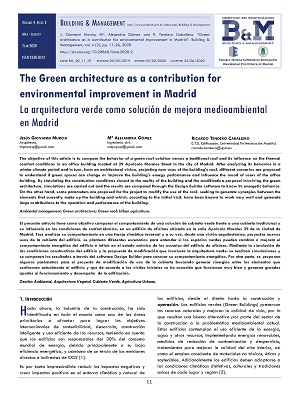
The Green architecture as a contribution for environmental improvement in Madrid = La arquitectura verde como solución de mejora medioambiental en Madrid
DOI: https://doi.org/10.20868/bma.2020.2.4692
Texto completo:
PDFResumen
Abstract
The objective of this article is to compare the behavior of a green roof solution versus a traditional roof and its influence on the thermal comfort conditions in an office building located at 29 Apolonio Morales Street in the city of Madrid. After analyzing its behavior in a winter climate period and in turn, from an architectural vision, projecting new uses of the building's roof, different scenarios are proposed to understand if green spaces can change or improve the building's energy performance and influence the mood of users of the office building. By simulating the construction conditions closest to the reality of the building and the modification proposal involving the green architecture, simulations are carried out and the results are compared through the Design Builder software to know its energetic behavior. On the other hand, some parameters are proposed for the project to modify the use of the roof, seeking to generate synergies between the elements that currently make up the building and which, according to the initial visit, have been known to work very well and generate large contributions to the operation and performance of the building.
Resumen
El presente artículo tiene como objetivo comparar el comportamiento de una solución de cubierta verde frente a una cubierta tradicional y su influencia en las condiciones de confort térmico, en un edificio de oficinas ubicado en la calle Apolonio Morales 29 de la ciudad de Madrid. Tras analizar su comportamiento en una franja climática invernal y a su vez, desde una visión arquitectónica, proyectar nuevos usos de la cubierta del edificio, se plantean diferentes escenarios para entender si los espacios verdes pueden cambiar o mejorar el comportamiento energético del edificio e influir en el estado anímico de los usuarios del edificio de oficinas. Mediante la simulación de las condiciones constructivas del edificio y la propuesta de modificación que involucra la arquitectura verde, se realizan simulaciones y se comparan los resultados a través del software Design Builder para conocer su comportamiento energético. Por otra parte, se proponen algunos parámetros para el proyecto de modificación de uso de la cubierta buscando generar sinergias entre los elementos que conforman actualmente el edificio y que de acuerdo a las visitas iniciales se ha conocido que funcionan muy bien y generan grandes aportes al funcionamiento y desempeño de la edificación.
Palabras clave
Referencias
M. Casini, «1 - Designing the third millennium’s buildings», en Smart Buil-dings, Woodhead Publishing, 2016, pp. 3-54.
«What is green building? | World Green Building Council». [En línea]. Dispo-nible en: http://www.worldgbc.org/what-green-building. [Accedido: 01-jun-2018].
«Cities Alive Green Building Envelope - Arup». [En línea]. Disponible en: http://www.arup.com/publications/research/section/cities-alive-green-building-envelope. [Accedido: 01-jun-2018].
«About Green Roofs», Green Roofs for Healthy Cities. [En línea]. Disponible en: https://greenroofs.org/about-green-roofs/. [Accedido: 01-jun-2018].
«World Urbanization Prospects - Population Division - United Nations». [En línea]. Disponible en: https://esa.un.org/unpd/wup/. [Accedido: 01-jun-2018].
«It’s Alive | Arup Foresight». [En línea]. Disponible en: http://www.driversofchange.com/projects/its-alive/. [Accedido: 02-jun-2018].
«Cities Alive Rethinking green infrastructure - Arup». [En línea]. Disponible en: http://www.arup.com/publications/research/section/cities-alive-rethinking-green-infrastructure. [Accedido: 01-jun-2018].
«Pasona Urban Farm by Kono Designs», Dezeen, 12-sep-2013. [En línea]. Dispo-nible en: https://www.dezeen.com/2013/09/12/pasona-urban-farm-by-kono-designs/. [Accedido: 31-may-2018].
J. Breuste, J. Schnellinger, S. Qureshi, y A. Faggi, Urban Ecosystem services on the local level: Urban green spaces as providers, vol. 32. 2013.
Lafortezza R, Carrus G, Sanesi G, Davies C. Benefits and well-being perceived by people visiting green spaces in periods of heat stress. Urban Forestry & Urban Greening. 2009;8(2):97-108.
W. Valley y H. Wittman, «Beyond feeding the city: The multifunctionality of urban farming in Vancouver, BC», City, Culture and Society, abr. 2018.
«Young British inventor wins top UN Environmental award», UN Environment. [En línea]. Disponible en: http://www.unenvironment.org/news-and-stories/press-release/young-british-inventor-wins-top-un-environmental-award. [Accedido: 12-mar-2018].
«Julia Ayuso | Diseño de espacios de trabajo de alto rendimiento», Julia Ayuso. [En línea]. Disponible en: https://www.julia-ayuso.com/. [Accedido: 04-jun-2018].
Ambius Fact Sheet: Plant life balance [Internet]. - [cited 2018 May 31]. Availa-ble from, [http://www.ambiusindoorplants.com.au/news/latest-news/AMB468%20%20Fact%20Sheet%20PLB%209-5.pdf]
Burchett, M., Torpy, F., Brennan, J., & Craig, A. (2010). Greening the great indoors for human health and wellbeing. Sydney: Plants and Indoor Environmental Quality Group, Centre for Environmental Sustainability (CEnS).
Enlaces refback
- No hay ningún enlace refback.
Copyright (c) 2021 Autor / BY-NC-ND

Este obra está bajo una licencia de Creative Commons Reconocimiento-NoComercial-SinObraDerivada 4.0 Internacional.










